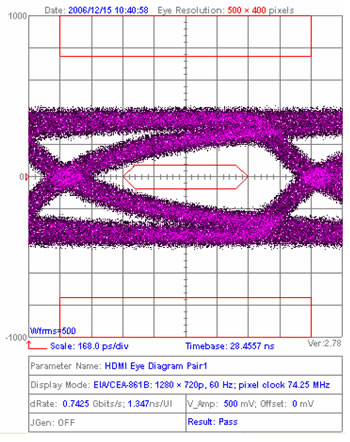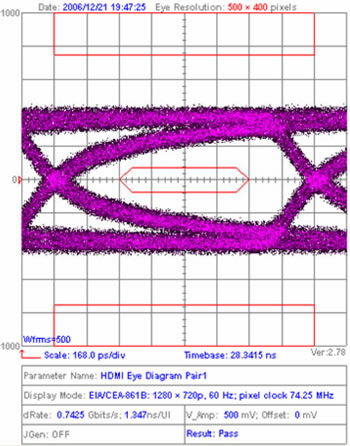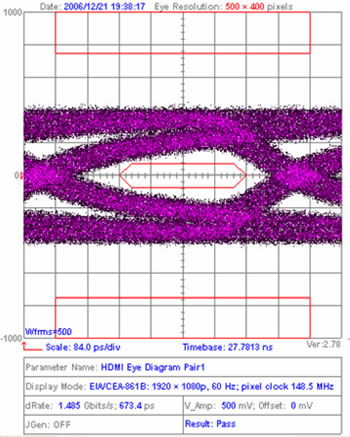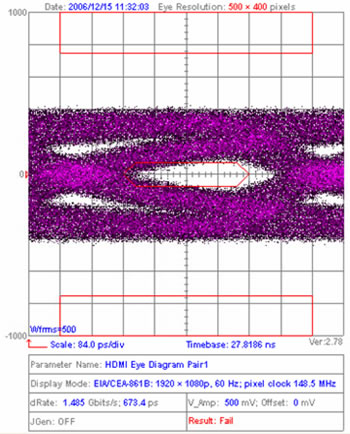NOTE: This article is downright ancient, but we maintain it here as sort of an "archive" reference.
Belden HDMI Cable Update
Ever since we announced that we had an HDMI cable in development with Belden, we've had a slew of inquiries about what the product will be like, and when it'll be available. The purpose of this article is to provide an update on the status of this new product, and give a preview of what its benefits will be. If all you're looking for is the quick "when-can-I-buy this" answer: at this writing (May 2007) we expect Belden-built cables for HDMI to be available approximately in early July of 2007, and as that date approaches, we'll be publishing pricing and other details.
Why Belden HDMI?
HDMI is a demanding standard; as you know if you've read some of our other articles on the subject, our view is that HDMI is an excessively fragile interface, and that the cable itself was not a well-thought-out part of that interface. In particular, running very high bitrates down twisted-pair cable is inherently problematic because of the poor impedance stability of twisted pair cable.
In the data-cable world (and remember this: HDMI is really a data cable masquerading as a video cable!) there is a whole range of cable quality, from very cheap to relatively costly. Chinese factories produce generic CAT 5 cable, and other data products, at exceptionally low prices; but the best data cables, for applications like Gigabit Ethernet, come not from China but from a handful of producers in the world's mature industrial economies, foremost among which is the United States.
HDMI cable, though, at this writing, all comes from one place: China. That fact surprises a lot of people, because with some cables bearing American brand names and very high prices, it's often assumed that those cables are made here. The reality is that as of today, every HDMI cable on the market is made by one of a handful of companies in China; there are a few Chinese factories that produce the bulk cable, and there are a number of assembly houses where the cable is cut, connectorized and packaged. One easy way to verify this is simply to look at the HDMI Licensing organization's list of HDMI adopters. What's notable about this list is not so much who is on it, but who is not. Most of the brand names under which HDMI cables are sold in America are missing from the list, including the ones seen in every big-box electronics store in the US. Why is that? Well, to use the HDMI trademarks in marketing, one has to either be an HDMI Adopter, or buy the cable from an HDMI Adopter; since the major American brands buy their HDMI cable assemblies from Chinese companies and then resell them, they have no need to become HDMI Adopters themselves. Even the handful of American companies on the list buy their cable assemblies from Chinese companies, and are on the Adopter list only because they also produce other HDMI devices.
We built our business selling Belden cable (and by the way: that's BelDEN, not BelKIN; Belkin is a completely different company, which sells Chinese-built HDMI cables, among other things). Belden is the leading name in the broadcast world for high-quality cable made to exacting tolerances; and we knew that Belden had a few tricks up its sleeve (which we'll get to in a moment) when it comes to high-speed data cabling. We asked ourselves: Why shouldn't an HDMI cable be made in America, rather than in China? Why shouldn't the best data-cable technology be applied to this demanding application? And why was nobody doing anything about it?
Getting it off the Ground
We first began to inquire of Belden about HDMI cable back in 2004. At first, there wasn't a lot of interest, probably because there wasn't, at that time, really a substantial market for this cable. But we kept pressing the issue with a variety of sales and product reps there, because (1) we knew this was a growing part of the market, and (2) we knew that Belden held proprietary patented technology that could be uniquely useful for building HDMI cable. In particular, Belden invented a process for making what it calls "bonded pairs." In a bonded pair, instead of simply twisting two wires together, a pair is formed by bonding the dielectric on the two wires together, and the principal effects are (1) to make the impedance of the pair much more consistent, and (2) to help hold that consistency when the cable is bent, twisted, or otherwise handled. Because HDMI's transmission-distance problems have a great deal to do with impedance stability, bonded-pair technology held the promise of making HDMI connections more reliable, at higher bandwidths, and under a greater variety of installation conditions, than could be done with conventional twisted pairs.
After we'd pumped the idea of a Belden bonded-pair HDMI cable for a while, it was becoming clear that Belden wasn't likely to simply introduce such a cable as a standard product any time in the near term; if this product was going to hit the market, it would be as a custom product developed specifically for us. We've had other custom products built by Belden, notably our YC-2 s-video cable and our LC-1 Analog Audio Cable, but HDMI cable is at a whole new level of complexity, with nineteen conductors and a variety of tricky issues. We visited Belden's main factory and engineering lab in Richmond, Indiana in December 2005 to meet with engineers and product development specialists and get this project moving.
An aside: Belden's engineering lab, which we visited then, is an extraordinary facility. The lab is as large as many wire and cable companies' entire production facilities, and has nearly every capability that Belden's full-scale factory has. Belden uses this lab to produce small batches of product for prototyping and testing, and this is where it would produce our sample reels. Wire and cable manufacture is a large-scale, heavy industrial process; but the Belden engineering lab is sort of the scaled-down old-world-craftsmanship version of that process, with enormous attention to detail directed at producing small quantities of new products, or introducing new production processes and controls.
At our meeting, the product development team agreed to put together a sample reel of our proposed HDMI cable design; this would be a cable with 24 AWG bare copper signal conductors, arranged in bonded pairs. David DeSmidt, a Senior Product Development Engineer who had done some previous work with DVI cable prototyping, was assigned the design, and a few months later, we had a sample reel--to our knowledge, the first reel of cable ever built in the US for HDMI applications.
This sample reel performed extremely well in our in-use testing and in sweep and eye-pattern tests. We had standard-definition 480p signals running flawlessly at 180 feet, and 720p and 1080i running flawlessly at 100 feet (we didn't get to testing lengths between 100 and 140--so it's likely that 100 was not the limit). Even so, though, the sample reel was not actually the best Belden could do. Belden had never built shielded bonded pairs, and the impedance of such a pair, while it can be estimated by formula, needed to be worked out in practice, under real production conditions; these pairs wound up at about 94 ohm impedance in this reel and needed a bit of revision to bring them to 100 ohms. There were a couple of other additional design issues to deal with, too, and we worked out details and ordered another sample reel to be built.
That sample reel, after some production delays, finally arrived in Seattle in December 2006, and was spot-on for impedance. We had tweaked the dielectric dimensions, and slightly increased the signal conductor size (from 24 AWG to 23.5 AWG). We began conducting in-use testing in our own shop, and found that the functioning distances were similar to those of our first sample reel. When we got to 1080p, however, we found that our own in-use testing setup was not really adequate for us to reach good conclusions; it's very hard to build a breakout adapter for length testing that doesn't introduce its own impedance issues, because the bitrate (1.485 Gbps) is so fast, and consequently the wavelength of the signal is so short that even splitting the pairs out to adapters for testing compromises the performance of the cable.
A few months later, in March and again in May of 2007, we were able to do further in-use testing with prototype "finished" cable assemblies, which eliminated the breakout-adapter problem, and the results were very encouraging. Using an upconverting Toshiba DVD player as the source, and both a Sony CRT HD display and a Panasonic 1080p plasma display as our receiving devices, we found that the picture was perfect at 480p at 175 feet; at 720p and 1080i at 150 feet; and at 1080p at 125 feet. We have never encountered a cable that could handle these distances without using amplification, active EQ'ing, or fiber-optic conversion to do so; and active devices in the line can sometimes introduce as many problems as they solve, so our preference has always been to avoid the expense and the complication. If it can be done in nothing but copper, we'd just as soon do it in nothing but copper.
The Eye-Pattern Testing
The best single test for comparing HDMI cables against one another is something called an "eye-pattern" test. The eye-pattern test results are hard to convey by any means other than graphically; there is no single number that correctly sums up the results of the test, because it's really, as we'll show, a sort of multidimensional problem very unlike conventional electrical specs like resistance which can be readily stated as a single value.
An eye pattern test is generated by running signal through the HDMI cable's pairs and using a sampling oscilloscope to measure the signal at the other end of the cable. A pseudorandom bit sequence is sent, and the rise and fall of the voltage relative to time is shown graphically on the resulting chart, in a scatter diagram of sample readings; the result is a series of fuzzy lines. Although these fuzzy lines aren't really traces of the signal, it's reasonable to think of them as signal traces, because they show the region within which the traces, if they could actually be closely followed, would always fall. Here is an example:

The left-to-right axis on the diagram is time; the up-and-down axis is voltage. The originating signal (not shown here) has a very sharp rise and fall time, but any cable will alter that pattern as well as altering the amplitude of the rise and fall. The amplitude of the rise and fall is more or less tied to the total attenuation of the cable at the relevant frequencies, and the slope of the rise and fall is affected by a variety of factors, including the cable's capacitance and inductance, and return loss resulting from changes in impedance along the way. Return loss bears an uneven relationship to frequency, but in general, as frequency increases, so does return loss. Capacitance also causes different losses at different frequencies, but in a much more even and predictable pattern, with higher frequencies suffering more loss than lower. As one chops out bits of the high-frequency content of the signal, the slope of the rise and fall of voltage gets more and more gradual (this is because a square, or nearly-square, wave like the originating signal consists of its fundamental frequency and an infinite series of harmonics; those high harmonics are required to produce a very fast rise or fall time, and as they get stripped away, the rise or fall time becomes more gradual); if we made the cable long enough, eventually we wouldn't see the voltage rise or fall meaningfully at all--the energy of the signal would dissipate itself by storing and releasing itself from the cable's capacitance, reflecting back and forth within the cable, and burning up as resistance, leaving nothing to deliver to the destination.
In the middle of the eye diagram is a flattened hexagon. This is the "eye mask," and it determines whether the cable being tested is deemed to have passed or failed the eye diagram test. The signal traces are not supposed to cross into the region of the eye mask. If they do, the cable fails the test. Any cable, no matter what its characteristics, will fail the test at some length, and a principal object of good cable design is to make that failure length as long as possible. Most failures will occur at the left end of the eye mask; for any given cable, as the cable gets longer, the attenuation will shrink the vertical dimension, and capacitance and return loss will smooth the slope of the rise and fall, and the trace will start to come into contact with the left portion of the eye mask. If we compare cables with excellent return loss against cables with poor or moderate return loss, we'll see the difference primarily in the rise and fall slopes; the lower the return loss, the steeper the slopes.
The relationship of this test to the HDMI interface is pretty straightforward. A "sink," that is to say, a device that receives an HDMI signal, is required by the HDMI spec to be able to read a signal which conforms to this eye pattern test, and a "source," which generates an HDMI signal, is supposed to produce a signal which is at least as good as the originating signal employed in the test. If the source produces a signal at least that good, and the cable delivers the signal at least well enough to meet the eye pattern test, the display should be able to reconstitute the digital signal without errors. Now, that doesn't mean that a cable that fails the test will necessarily fail in use; there is some wiggle room. The eye-pattern test originating signal is a "worst-case" signal, about 1 dB below the target spec (it's 780 mV, rather than 1 Volt). Sources are supposed to generate a signal somewhat better than that, and the sink will often be able to reconstitute a signal that doesn't quite meet the eye pattern test. But once the eye-pattern test fails, the cable is very definitely in the "danger zone"; it may work on some source-and-display combinations and not others.
Eye-pattern testing can be run at a variety of bitrates, and a cable may fail at one bitrate and pass at another. Because the higher frequencies are harder to convey without significant return loss, and because attenuation grows higher as frequency increases, a cable which barely passes eye-pattern testing at a low bitrate will fail at a higher bitrate; and because return loss corresponds only roughly with frequency, and is inherently hard to control and predict, one cannot easily tell by looking at a low-frequency eye pattern how the cable is likely to perform at a higher frequency.
This presents a problem for future-proofing, because of the variety of resolutions and color depths HDMI is supposed to support. Many HDMI cables have been installed to run standard-definition output from DVD players, at 480p. The clock frequency at 480p is 27 MHz, making the bitrate in each pair (which runs at 10 bits per clock pulse) 270 Mbps. (Note: in this article we use the "per-pair" bitrate; you will sometimes see writers use the "total" bitrate of the three pairs, which is triple the per-pair number, but since from an engineering perspective the total bitrate doesn't really mean anything, we prefer to speak in terms of the per-pair rate.) 720p and 1080i both run the clock at 74.25 MHz, for a bitrate of 742.5 Mbps; and 1080p doubles that, for a bitrate of 1.485 Gbps. But these bitrates are at standard color depth of eight bits per color component per pixel (the actual signal contains ten bits/pixel but the "color depth" is eight bits; here again, terminology can be confusing and you'll sometimes see this being called "24-bit" color because the three color channels contain a total of 24 bits per pixel). Beginning with HDMI version 1.3, the interface supports "deep color," which calls for additional bits (up to a total of 20) to be sent on each clock pulse. So, while the 1080p clock rate stays at 148.5 MHz, the bitrate can be double the "standard-color" rate: 2.97 Gbps. It is fair to say that this is quite a task for a twisted-pair cable to take on; and it's also clear that a cable which does just fine running 270 Mbps, standard-definition, standard-color-depth video can utterly fail to operate at 2.97 Gbps, which is eleven times the bitrate. What this means, of course, is that one may install a cable today, and confirm that it works well with the equipment it's now hooked up to, and one day in the future discover that it no longer works with new equipment. If the cable has been mounted permanently behind drywall, that, of course, can be a very disappointing, not to mention burdensome, discovery.
As a result, we wanted this cable to have some serious "headroom." It should work with today's equipment, but it should also work with tomorrow's; and that requires that the cable do more than barely meet the spec. We're pleased to be able to say that the Belden bonded-pair cable does indeed meet that objective, and will be the safest product on the market for the user who wants his cable to be future-proof.
Here are some eye diagrams that show just what we're talking about. We'll compare the Belden HDMI cable against an excellent Chinese cable: our current HDMI cable product, the BJC Series-2. First, here are two eye diagrams at 74.25 MHz clock (742.5 Mbps), on 50-foot cables:
Belden | Chinese |
 |  |
As you can see, the Chinese cable passes spec at 74.25 MHz at 50 feet, but the traces of the rise and fall are starting to come close to the eye mask. If we made this cable a bit longer, or increased the bitrate, it wouldn't pass the eye pattern; but the Belden cable still has some room around the eye mask, and could be made longer without dipping into the mask area. And, speaking of increasing the bitrate: here are the eye patterns for the same 50-foot cables, at 1080p.
Belden | Chinese |
 |  |
At 1080p, the 50 foot Belden cable just passes the eye-pattern test, and the Chinese cable fails. There are a couple of points we should touch on here; first, spec failure is not the same as in-use failure. We've tested our 50-foot Series-2 HDMI on a 1080p source and monitor combination, and it works fine; the fact that it fails spec doesn't mean it will fail in any particular application, but it does present at least some danger of failure. Second, this is an excellent Chinese cable; it will pass the 148.5 MHz eye pattern test at 30 feet, which is about as far as any Chinese cable will go. But the improvement in going to the Belden bonded pair is clear and unmistakable.
Another note: it's always important, if you're comparing our eye pattern against an eye pattern test of another cable, to be sure you're not comparing apples and oranges. A poor-but-passable 3-foot cable will substantially outperform the best 50-foot cable, and a lousy 50-foot cable run at 27 MHz clock for standard-def will give a much nicer-looking eye than the best 50-foot cable at 1080p. There are plenty of eye-pattern tests that are more "open" than these, but for these lengths and resolutions you will not find a better eye pattern test than the Belden cable generates.
Does it Matter?
Now, there is always, with HDMI, the question: does it matter? This is, after all, a digital signal, and will ordinarily generate only one of three types of results: perfect performance, noticeable partial failure (manifested by "sparkly" dropouts and/or flashing/loss of sync), or total failure (manifested by complete absence of a recoverable signal, and therefore a blank screen). The answer, of course, is that any cable which performs perfectly in a particular application is as good as any other cable which performs perfectly in that same application--but here there is a caveat, which we will pose as a question.
How do we know that the application today will be the same as the application tomorrow? The HDMI spec is updated from time to time, and the trend has been toward encouraging device manufacturers to use more and more bandwidth, with the current spec calling for clock speeds as high as 340 MHz (and bitrates 10 times higher). A year ago (this sentence being written in December 2006), consumer devices which handle 1080p were rare, and the most demanding application for an HDMI cable was 720p or 1080i, at half the 1080p speed. Today, devices that handle "deep color" are rare; in a year, two years, or five years, they may be common. The fact that a cable works today, on certain devices and at certain resolutions and color depths, is no assurance that it will work tomorrow, on other devices at other resolutions and color depths. Meanwhile, as the number of consumer devices that put out HDMI signals increases, the need to switch HDMI signals, whether in an AV receiver circuit or in a switchbox, is growing; switches always present increased opportunity for impedance mismatch, increased return loss, and increased crosstalk, and a switch can burn up whatever headroom there is between your cable's performance and the minimum performance required to deliver clean signal. In other words: the cable that performs flawlessly in your system today may not function at all in your system tomorrow, and the best defense against the future demands of AV equipment is to be sure that there's as much performance headroom as possible.


